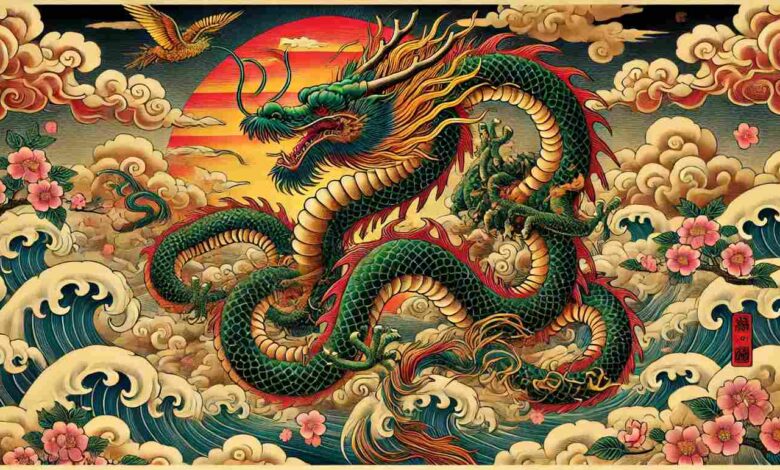Japan Dragon Myths: How Ancient Tales Inspire Modern Art

Japanese dragon myths have long captivated the imagination, blending history, mythology, and art into a rich tapestry that spans centuries. These dragons, known as ryū or tatsu, are distinctive in their appearance and symbolic meaning. Unlike the fire-breathing Western dragons, Japanese dragons are benevolent creatures closely tied to water and nature, representing wisdom, strength, and protection. This article explores how ancient dragon myths continue to inspire modern art in Japan, bridging the past with contemporary culture.
The Origins of Japanese Dragons
While they share their origins in Chinese mythology, the Japanese dragons have morphed into a distinct being that mirrors Japan’s own societal values. Their bodies were long, serpentine, and wingless, in stark contrast to the Western dragon. Most often depicted with eagle talons, a body like a snake, and the antlers of a deer—combining parts from different animals to illustrate their otherworldly and mighty status.
One of the most common things about Japanese dragons is their connection with water. They are normally seen as deities of the rivers, lakes, and seas, representing both fecundity and mastery over natural forces such as rain. Some stories have them holding back natural disasters or giving direction to sailors, even moving and causing the tides. Their proximity to water means they are an important presence in a country regularly hit by floods, typhoons, and tsunamis.
Famous Japanese Dragons in Mythology
Japanese Dragons Asian dragon myths are many and varied, but two of the main dragons in Japanese mythology include Ryūjin (pictured), the Dragon King of the Sea, and Yamata no Orochi, a grotesque eight-headed serpent.
Ryūjin, a sea god, lives in an undersea palace where he keeps all the marine creatures of creation and controls tides. His mermaid often used legendary precious tide-controlling jewels to beautify the lives of human beings and provide them with gifts or advice. The underwater palace of Ryūjin, a grand coral-encrusted palace made of crystal (seen by the humble Goemon as palaces for all forms of life) is a motif common to Japanese art.
Yamata no Orochi, on the other hand, was more of a cruel side to dragon mythology. The most noteworthy version of this dragon is the one that tormented villages until a god named Susanoo killed it, and legend tells of the destruction as being victorious in turning the tides against evil. The legacy of Orochi has cast a long shadow over Japanese literature, art, and pop culture to this day as video games like Warriors Orochi or anime such as Samurai Champloo continue to reference the mythical beast.
Dragons in Japanese Buddhism and Shintoism
Apart from mere mythology, dragons have an irrefutably deep-seated place in Japanese religion especially within Buddhism and Shinto religious practices. Dragons are regarded as guardians in Buddhism, seen to often protect sacred sites such as temples and relics. For instance, many temples use dragons in their architecture to symbolize spiritual protection and the journey towards enlightenment.
An iconic scene in the Sensoji Temple of Tokyo, which features a golden dragon that if enters the temple would bring prosperity. It is also a testament to the importance of dragons in Japanese faith and folklore.
The Influence of Dragons on Japanese Art
Over the centuries, Japanese dragons and their mystic presence have inspired artists to create some of the most beautiful works capturing them in nature. The dragons of traditional art — found in ink paintings and woodblock prints, for example — featured dragons flying through the air or emerging dramatically from the ocean depths: they stood as symbols of dominion over both sky and sea. There are very culturalistic images, as well as kinda like balance — exactly between something that natural you want to be afraid of, but not afraid of it literally with this protection.
One of the most iconic motifs is that of black koi swimming upstream through Dragon Gate and transforming into a dragon. This tale of perseverance and metamorphosis has been the subject of classic and contemporary art. The dragon represents an icon of personal development, serving as both a challenge to overcome and the mountain top to reach.
Dragons in Modern Japanese Media and Popular Culture
Even though the old traditional artwork of dragons has survived through time, their cultural legacy still lives on in modern media and pop culture alongside anime, manga, and video games. Dragons are also symbols of resilience, strength, and the fruits of labor, as demonstrated in shows like Dragon Ball, where dragons represent a strong, wishful creature to give or take away. Their appropriation in contemporary narratives is a testament to the longevity of dragon myths and their ability to convey new ideas.
On top of that, there is a rise in dragon tattoos (ryū tatou) used all over the world and Japan, which reflects strength, wisdom, as well as protection. These tattoos are not generally just ornamental, as they can have superb meaning and even represent how different colors and styles typically relate to the dragon shown.
Festivals and Traditions Celebrating Dragons
People across the nation still worship these magical creatures each year, as they become the stars of Japanese festivals. The most popular events include the Dragon Boat Festival, where the festival goers devote the water gods with dragon-shaped boats to wish for good crops and shield against drought. These figures are also a New Year’s symbol, one which spotlights the dragon especially around the aegis of The Chinese zodiac, which declares each year anew by its corresponding animal- in this way, just before eventide ushers in waning light.
Festivals that absorbed dragon myths prove how inscribed in cultural norms these creatures are for Japan. While this has certainly helped, my suspicion is that their lasting impact owes at least as much to the deep-seated mythology they tap into – as well perhaps the surprisingly enduring presence of these spirits in Japanese society to this day.
The Bottom Line
Japan dragon are not just mythical creatures – they are representations of wisdom, protection and natural balance that have influenced countless aspects of Japanese art, religion and culture through the centuries. The imagery of the dragon continues to resonate through the human psyche, from ancient legend to contemporary art, inspiring generation after generation.
Whether a stroke of ink on paper, the vibrant colours adorning living flesh, or characters from an animel the spirit of the dragon continues in Japan through one form or design to another, continuing to remind us of how timeless myths work their magic. To delve further into these ancient legends can help us to understand how the Japanese dragons have left their mark on both history and culture. From protectors to imperialist emblems, dragons will always inspire artists and writers for generations.





